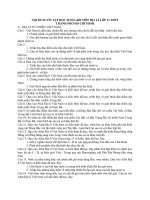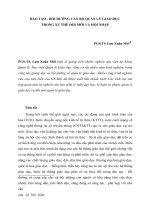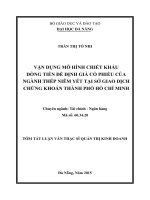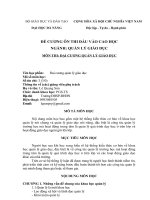The impact of board structure on financial leverage of Vietnamese listed firms - TRƯỜNG CÁN BỘ QUẢN LÝ GIÁO DỤC THÀNH PHỐ HỒ CHÍ MINH
Bạn đang xem bản rút gọn của tài liệu. Xem và tải ngay bản đầy đủ của tài liệu tại đây (332.96 KB, 10 trang )
<span class='text_page_counter'>(1)</span><div class='page_container' data-page=1>
<b>THE IMPACT OF BOARD STRUCTURE ON FINANCIAL </b>
<b>LEVERAGE OF VIETNAMESE LISTED FIRMS </b>
<b>Hoang Mai Phuonga*<sub>, Nguyen Thanh Hong An</sub>a</b>
<i>a<sub>The Faculty of Economics and Business Administration, Dalat University, Lam Dong, Vietnam </sub></i>
<i>*<sub>Corresponding author: Email: </sub></i>
<b>Article history </b>
Received: November 1st<sub>, 2020 </sub>
Received in revised form: November 22nd<sub>, 2020 | Accepted: November 30</sub>th<sub>, 2020 </sub>
<b>Abstract </b>
<i>This study examines the impact of board structure on financial leverage decisions, as </i>
<i>measured by the ratio of total debt to total assets, of nonfinancial firms listed on the Ho Chi </i>
<i>Minh City Stock Exchange. Based on a dataset of 1,592 observations collected from 199 firms </i>
<i>for the period from 2012 to 2019, the analysis shows a correlation between board </i>
<i>characteristics and a firm’s financial leverage. Specifically, the higher the number of annual </i>
<i>board meetings or the larger the number of female members on the board of directors, the </i>
<i>lower the rate of financial leverage. On the other hand, the size of the board and the presence </i>
<i>of CEOs on the board do not have a significant influence on financial leverage decisions. A </i>
<i>robust test using the system of generalized method of moments (GMM) to control for </i>
<i>endogeneity generally confirms the results. </i>
<b>Keywords</b>: Agency theory; Board structure; Capital structure; Corporate governance;
Financial leverage; Vietnamese listed firms.
DOI:
Article type: (peer-reviewed) Full-length research article
Copyright © 2020 The author(s).
</div>
<span class='text_page_counter'>(2)</span><div class='page_container' data-page=2>
<b>TÁC ĐỘNG CỦA CẤU TRÚC HỘI ĐỒNG QUẢN TRỊ LÊN ĐỊN </b>
<b>BẨY TÀI CHÍNH CỦA CÁC DOANH NGHIỆP NIÊM YẾT TẠI </b>
<b>VIỆT NAM </b>
<b>Hoàng Mai Phươnga*<sub>, Nguyễn Thanh Hồng Ân</sub>a</b>
<i>a<sub>Khoa Kinh tế - Quản trị kinh doanh, Trường Đại học Đà Lạt, Lâm Đồng, Việt Nam </sub></i>
<i>*<sub>Tác giả liên hệ: Email: </sub></i>
<b>Lịch sử bài báo </b>
Nhận ngày 01 tháng 11 năm 2020
Chỉnh sửa ngày 22 tháng 11 năm 2020 | Chấp nhận đăng ngày 30 tháng 11 năm 2020
<b>Tóm tắt</b>
<i>Nghiên cứu này kiểm chứng sự tác động của cấu trúc hội đồng quản trị tới quyết định địn </i>
<i>bẩy tài chính, cụ thể là tỷ lệ tổng nợ trên tổng tài sản, của các doanh nghiệp phi tài chính </i>
<i>niêm yết tại Sở giao dịch chứng khốn Thành phố Hồ Chí Minh trong vòng tám năm từ năm </i>
<i>2012 đến 2019. Dựa trên bộ dữ liệu gồm 1,592 quan sát thu thập từ 199 doanh nghiệp, kết </i>
<i>quả phân tích cho thấy có mối tương quan giữa đặc điểm hội đồng quản trị và địn bẩy tài </i>
<i>chính. Cụ thể, số lượng cuộc họp hội đồng quản trị hàng năm càng nhiều hay số lượng thành </i>
<i>viên nữ trong hội đồng quản trị càng lớn thì tỷ lệ địn bẩy tài chính càng thấp. Trong khi đó, </i>
<i>quy mơ hội đồng quản trị và vai trò kiêm nhiệm của giám đốc điều hành khơng có ảnh hưởng </i>
<i>đáng kể tới các quyết định tài chính. Các phương pháp kiểm định tăng cường, mơ hình động </i>
<i>và phương pháp ước lượng system-GMM được sử dụng để ước lượng hệ số hồi quy, tăng tính </i>
<i>chính xác và khẳng định kết quả thu được từ mơ hình nghiên cứu. </i>
<b>Từ khóa: </b>Cấu trúc hội đồng quản trị; Cấu trúc vốn; Công ty niêm yết tại Việt Nam; Địn bẩy
tài chính; Lý thuyết người đại diện; Quản trị doanh nghiệp.
DOI:
Loại bài báo: Bài báo nghiên cứu gốc có bình duyệt
Bản quyền © 2020 (Các) Tác giả.
</div>
<span class='text_page_counter'>(3)</span><div class='page_container' data-page=3>
<b>1. </b> <b>INTRODUCTION </b>
In recent years, along with the development of the stock market in Vietnam, the
number and quality of listed companies have continuously improved. Today's businesses
are not only larger in scale but also increasingly professional and diversified in their
operations. In this context, abundant capital is a prerequisite for businesses to maintain
and expand production and to promptly meet their growth needs. Therefore, choosing an
appropriate capital structure is an important financial decision that businesses need to
consider to achieve the expected performance.
Corporate governance is an emerging field of research in Vietnam. In recent years,
empirical work has mainly focused on (1) finding the factors that affect the governance
structure or capital structure, and (2) examining the effects of ownership structure,
governance structure, and capital structure on financial performance, leaving the
relationship between governance structure and capital structure underexplored.
Therefore, examining the relationship between the governance structure and capital
structure of listed companies in Vietnam is necessary and can provide useful insights.
This is especially important in the context of an integrated economy, where Vietnamese
businesses are in dire need of effective management strategies to improve
competitiveness as well as corporate value.
Based on the agency theory of Jensen and Meckling (1976), one of the
fundamental theories of corporate governance, we argue that the characteristics of the
agent, in this case the board of directors, can influence the financial decisions of
businesses, particularly financial leverage decisions. Using a dataset of 1592 observations
collected from 199 nonfinancial companies listed on the Ho Chi Minh City Stock
Exchange from 2012 to 2019, our research results show that, in general, the characteristics
of the board of directors have an impact on the financial leverage ratio of businesses.
Firms with active boards of directors, represented by the number of meetings per year,
often control their financial leverage at a lower level than businesses with less active
boards of directors. In addition, the more women present on the board of directors, the
lower the level of leverage in general. On the other hand, board size and the presence of
the Chief Executive Officer (CEO) on the board have no significant impact on financial
leverage.
</div>
<span class='text_page_counter'>(4)</span><div class='page_container' data-page=4>
The paper is organized as follows: First, we briefly present the basic theory and
empirical studies on the relationship between governance structure and capital structure,
from which research hypotheses are developed. Then, the next section presents the
research method and the Models. Finally, we present and discuss the empirical results and
their implications.
<b>2. </b> <b>LITERATURE REVIEW AND HYPOTHESIS DEVELOPMENT </b>
<b>2.1. Literature review </b>
The seminal study of Modigliani and Miller (1958) is one of the initial studies on
capital structure. Their proposed theory is formulated in two important propositions
related to firm value and the cost of capital. Modigliani and Miller (1958) show that the
use of debt gives owners a higher rate of return, and their later theory (Modigliani &
Miller, 1963) shows that, with the existence of corporate income tax, the use of debt will
increase the value of the business. In other words, a reasonable level of financial leverage
will satisfy the requirements of managers (about the value of the business) as well as those
of shareholders (about income).
Following Modigliani and Miller’s (1963) research, a series of theories were built
with different perspectives on the corporate capital financing Model. Of these, the agency
theory of Jensen and Meckling (1976) is one of the prominent theories on the relationship
between optimal capital structure and governance structure in controlling conflicts of
interest between shareholders and managers. Conflicts of interest arise from the transfer
of certain decision-making powers to the agent in the relationship between the principal
(shareholders) and the agent (managers). Both sides want to advance their interests, and
there are always reasons to believe that the agent does not always act in the best interest
of the principal. In other words, the managers will be motivated to use the resources of
the business for their personal benefit instead of for the benefit of the shareholders.
</div>
<span class='text_page_counter'>(5)</span><div class='page_container' data-page=5>
structure. Their research shows that executives strive to avoid debt, and when there is no
demand from the shareholders, the debt ratio is kept at a lower-than-optimal level.
Consequently, if measures to minimize management entrenchment are applied, the
leverage ratio tends to increase.
Taking a closer look at the theoretical discussion on the relationship between
managers and shareholders addressed by agency theory, the divergence of interests
between shareholders and managers can be reduced by establishing effective monitoring
mechanisms to limit the managers' self-interested behavior. More specifically, the
decision to borrow is one of the monitoring options that makes managers hesitate because
this will place the business under the supervision of many outside parties. Hence,
understanding the effects of governance characteristics on capital structure decisions can
help us understand effective monitoring mechanisms. Empirical studies have shown that
a number of corporate governance characteristics, including board size, frequency of
meetings during the year, number of female members, and CEO duality, influence
corporate debt decisions. A brief discussion of board characteristics and their relationship
to financial leverage is given below.
<i>2.1.1. Board size and capital structure decisions </i>
A company's financing decisions are governed by its board of directors (BOD).
The operational efficiency of the BOD is the key to the success of the business. According
to Adams and Mehran (2003), a large board of directors can effectively monitor the
company's operations and provide better expertise. On the other hand, Lipton and Lorsch
(1992) claim that large boards perform less efficiently than small ones. Board size should
be limited to a maximum of ten members and boards with eight or nine members is the
most reasonable.
Existing studies on the relationship between board size and financial leverage
yield inconclusive findings. Berger et al. (1997) and Anderson, Mansi, and Reeb (2004)
find a significant, negative correlation between board size and financial leverage.
Conversely, the studies of Kyereboah-Coleman and Biekpe (2006), Abor (2007), Bokpin
and Arko (2009), and Rose, Munch-Madsen, and Funch (2013) find a positive
relationship between board size and the capital structure of businesses. This shows that
the effectiveness of the board in monitoring management behaviors can directly, or
indirectly, improve a company's access to debt. Finally, Wiwattanakantang (1999) and
Wen, Rwegasira, and Bilderbeek (2002) find no relationship between board size and
financial leverage.
<i>2.1.2. Number of board meetings and a firm’s financial leverage </i>
</div>
<span class='text_page_counter'>(6)</span><div class='page_container' data-page=6>
Chidambaran (2007) and Ntim and Osei (2011) find a positive relationship between the
frequency of board meetings and firm performance. Regular BOD meetings often tend to
produce better financial performance (Johl, Kaur, & Cooper, 2015) and the number of
board meetings should be at least four meetings each year according to Eluyela et al.
(2018). Buchdadi, Ulupui, Dalimunthe, & Pamungkas (2019) and Kajananthan (2012)
indicate that regular board meetings can lead to more debt decisions, thereby taking
advantage of outside capital to modernize, expand, exploit investment opportunities, and
increase the market value of the business. The study also uncovers the important role of
supervision through board meetings in agency theory. Firms with high leverage are also
likely to have more frequent board meetings (Al-Najjar, 2011). A study by Francis,
Hassan, and Wu (2015) finds that companies with infrequent board meetings performed
significantly worse during the financial crisis. Stephanus, Anastasia, and Toto (2014) find
a significant negative relationship between the frequency of board meetings and debt
ratio. Frequent board meetings can increase costs, time, and administrative support
requirements for a company.
<i>2.1.3. Board gender diversity and a firm’s financial leverage </i>
Globally, over the past two decades, female representation on corporate boards of
directors has increased significantly in a number of markets. At the same time, the issue
of board gender diversity has also been debated and is the basis to consider the impact of
female directors on a company's operations, including whether a greater presence of
women on a BOD affects corporate financial decisions, and why, in fact, few women are
on boards. The pioneering research on this topic was conducted by Morrison, White, and
Velsor (1987), and this topic has increasingly attracted the attention of many researchers
globally, both in developed and developing countries.
First, it has been shown that the maturity of a firm affects the composition of its
board. A high degree of board diversity is positively related to corporate financial results.
Looking at recent empirical studies, Tran, Hoang, and Tran (2015) investigate the impact
of gender diversity in the BOD on company performance and find that the proportion of
women directors on the board had a significant positive effect on the financial results of
banks in ASEAN from 2009 to 2013. A BOD is more active in the presence of at least
three female representatives. Gender-balanced boards are also more likely to replace
ineffective managers (Schwartz-Ziv, 2017). Rose et al. (2013) and Marinova, Plantenga,
and Remery (2015) studied the effects of women directors on the activities of companies
in Germany and the Nordic bloc in 2010. However, their results show that the proportion
of women on a BOD has no apparent influence on financial decisions. In two other
studies, Harris (2014) and Abobakr and Elgiziry (2015) find a significant negative
relationship between the proportion of female directors and financial leverage, especially
on boards where the presence of females accounts for 25% or more.
<i>2.1.4. CEO dual roles and a firm’s financial leverage </i>
</div>
<span class='text_page_counter'>(7)</span><div class='page_container' data-page=7>
decisions. Duality exists when the CEO of a company is also the chairman of the board.
On the one hand, according to Sheikh and Wang (2012), duality provides clear direction
from a single leader who can react more quickly to outside events. On the other hand,
duality increases the CEO's decision-making power by providing a broader base of power
and strengthening control (Boyd, 1995). As a result, assigning both tasks to the CEO can
weaken the board's control and influence financial decisions.
Empirical research on this relationship gives mixed results. Fosberg (2004) asserts
that a dual leadership structure is effective in increasing the amount of debt in a firm's
capital structure. Abor (2007) finds a significant positive relationship between CEO
duality and financial leverage. A CEO often tries to finance the company's operations
using debt capital instead of issuing new equity (Bokpin, & Arko, 2009). Meanwhile,
Kyereboah-Coleman and Biekpe (2006) find a clear negative relationship between CEO
duality and short-term and total leverage, asserting that agency costs increase when a
CEO is chairman of the board, which discourages investors from investing in the business.
They also report a positive link between CEO duality and long-term leverage, but this
relationship is not statistically significant. Research by Tarus and Ayabei (2016) also
confirms the negative relationship between CEO duality and financial leverage. CEOs
who are also chairs of the BOD are given too much power and have the ability to use less
financial leverage to avoid risks associated with borrowing. The study by Simpson and
Gleason (1999) examines the effect of CEO duality on the use of financial leverage at
300 banks. The results show that CEOs can influence the internal control system in a way
that reduces the likelihood of financial difficulties for the company. This means that they
take less risk, resulting in underuse of financial leverage.
<b>2.2. Research in Vietnam </b>
In Vietnam, recently published studies focus on finding factors that influence the
capital structure of firms listed on the Vietnamese stock markets. Specifically, Đặng and
Quách (2014) identify three factors that have a strong impact on the capital structure of a
firm, namely, firm size, profitability (positive impact), and taxes (negative impact).
Previously, Trương and Võ (2008) affirm that capital structure is positively correlated
with company size, industry, and revenue growth and is inversely correlated with
profitability. In addition, capital structure is positively correlated with the number of
directors. Recently, a series of studies on factors affecting the capital structure of firms in
specific industries was also conducted. The studies included firms in the logistics industry
(Lương, Phạm, Nguyễn, Nguyễn, Nguyễn, & Phạm, 2020), the food industry (Lê, Bùi, &
Lê, 2020), the Vietnam Oil and Gas Group (Vũ & Nguyễn, 2013), and the seafood
industry (Nguyễn, 2008). Most studies show that firm size, growth rate, and profitability
are positively correlated with capital structure. Some other factors that are negatively
correlated are also mentioned, including taxes, liquidity, profits, and business risk.
</div>
<span class='text_page_counter'>(8)</span><div class='page_container' data-page=8>
(2016) examine the impact of corporate governance (state ownership, financial
institutions, foreign investors, members of the BOD, and the largest shareholders of the
firm) and firm characteristics (size, profitability, tangible assets, tax shield, and the gap
between optimal leverage and observed leverage) on capital structure decisions. Research
results show that corporate capital structure not only depends on the characteristics of the
business, but is also influenced by enterprise ownership characteristics. In another study
by Phan, Trần, and Trần (2017), the role of CEO duality is examined. Their study
confirms that firms with a dual leadership structure performed more effectively.
As previous research is still inconclusive, a comprehensive study with a large set
of data on companies listed on the Vietnamese stock market would provide significant
insights into the relationship between BOD structure and capital structure (financial
leverage).
Based on the theory and previous research results, this study hypothesizes that:
• H1: Board size has an impact on financial leverage.
• H2: The number of annual board meetings has an impact on financial
leverage.
• H3: The number of female directors on the BOD has an impact on financial
leverage.
• H4: CEO duality has an influence on financial leverage.
<b>3. </b> <b>DATA AND RESEARCH METHOD </b>
<b>3.1. </b> <b>Definitions of variables and data collection method </b>
This study examines the relationship between the BOD structure and the financial
leverage of companies listed on the Vietnamese stock market. For quantitative analysis,
the authors use leverage ratio, which is defined as the ratio of total debt to total assets of
the firm, similar to the study by Haque, Arun, and Kirkpatrick (2011).
The independent variables used in this study include the size of the board, the
number of board meetings per year, the number of female directors on the board, and an
indicator variable indicating whether the chairman also holds a CEO position. To increase
the effectiveness of the estimate, two variables representing board size and the number of
board meetings were converted to logarithms prior to analysis. In addition to the number
of female directors on the board, the authors also use two other definitions of gender
diversity of the BOD, namely, the percentage of female directors on the board and an
indicator variable indicating the presence of female directors. Using different definitions
of the gender variable in the analysis will help increase the reliability of the results.
</div>
<span class='text_page_counter'>(9)</span><div class='page_container' data-page=9>
similar to studies on the effect of firm characteristics on financial leverage according to
Bradley, Jarrell, and Kim (1984), Castanias (1983), Long and Malitz (1985), and Titman
and Wessels (1988). These studies generally agree that financial leverage has a positive
relationship with firm size, fixed assets, and growth rate, and an inverse relationship with
returns and liquidity.
Detailed definitions of the variables are presented in Table 1.
<b>Table 1. Variable definitions </b>
Variable Code Definition/Formula
Dependent variable
Financial leverage Lev Total debt/Total assets
Independent variables
BOD size Lbsize Logarithm (Number of directors on the board)
BOD meeting frequency Lmeet Logarithm (Number of BOD meetings per year)
Female directors Female Number of female directors on the BOD
CEO duality Ceodual Equals 1 if the CEO is also the BOD chairman, 0 otherwise
Control variables
Firm size Lfsize Logarithm (Total assets)
Fixed assets Fixed_assets (Total assets - Short-term assets)/Total assets
Liquidity Liquidity Short-term assets/Short-term liabilities
Profitability ROA Net profit/Total assets
Growth Salegrowth Annual sales growth
The data are collected from audited financial reports, annual reports, and annual
executive reports of nonfinancial companies listed on the Ho Chi Minh City Stock
Exchange from 2012 to 2019. Companies with insufficient data are excluded from the
sample.
<b>3.2. </b> <b>Research method </b>
To analyze the relationship between the variables representing the characteristics
of the BOD and the leverage ratio, the authors propose the following research Model:
𝐿𝑒𝑣<sub>𝑖𝑡</sub> = 𝛽<sub>1</sub>+ 𝛽<sub>2</sub>𝐿𝑏𝑠𝑖𝑧𝑒<sub>𝑖𝑡</sub>+ 𝛽<sub>3</sub>𝐿𝑚𝑒𝑒𝑡<sub>𝑖𝑡</sub>+ 𝛽<sub>4</sub>𝐹𝑒𝑚𝑎𝑙𝑒<sub>𝑖𝑡</sub>+ 𝛽<sub>5</sub>𝐶𝑒𝑜𝑑𝑢𝑎𝑙<sub>𝑖𝑡</sub>
+ 𝛽<sub>6</sub>𝐿𝑓𝑠𝑖𝑧𝑒<sub>𝑖𝑡</sub>+ 𝛽<sub>7</sub>𝐹𝑖𝑥𝑒𝑑_𝑎𝑠𝑠𝑒𝑡𝑠<sub>𝑖𝑡</sub>+ 𝛽<sub>8</sub>𝑅𝑂𝐴<sub>𝑖𝑡</sub>+ 𝛽<sub>9</sub>𝐿𝑖𝑞𝑢𝑖𝑑𝑖𝑡𝑦<sub>𝑖𝑡</sub>
+ 𝛽<sub>10</sub>𝑆𝑎𝑙𝑒𝑔𝑟𝑜𝑤𝑡ℎ<sub>𝑖𝑡</sub>+ 𝜀<sub>𝑖𝑡</sub> (1)
</div>
<span class='text_page_counter'>(10)</span><div class='page_container' data-page=10>
variables in the Model, causing the estimate to be biased and inconsistent. Second, since
this Model does not take advantage of information from the differences between firms,
the estimates may be less accurate (Wooldridge, 2002).
As a remedy, the authors restructure Model (1) to incorporate the differences
among companies (representing by in the new Model) in the dataset:
𝐿𝑒𝑣𝑖𝑡 = 𝛽1+ 𝛽2𝐿𝑏𝑠𝑖𝑧𝑒𝑖𝑡+ 𝛽3𝐿𝑚𝑒𝑒𝑡𝑖𝑡+ 𝛽4𝐹𝑒𝑚𝑎𝑙𝑒𝑖𝑡+ 𝛽5𝐶𝑒𝑜𝑑𝑢𝑎𝑙𝑖𝑡
+ 𝛽<sub>6</sub>𝐿𝑓𝑠𝑖𝑧𝑒<sub>𝑖𝑡</sub>+ 𝛽<sub>7</sub>𝐹𝑖𝑥𝑒𝑑_𝑎𝑠𝑠𝑒𝑡𝑠<sub>𝑖𝑡</sub>+ 𝛽<sub>8</sub>𝑅𝑂𝐴<sub>𝑖𝑡</sub> + 𝛽<sub>9</sub>𝐿𝑖𝑞𝑢𝑖𝑑𝑖𝑡𝑦<sub>𝑖𝑡</sub>
+ 𝛽<sub>10</sub>𝑆𝑎𝑙𝑒𝑔𝑟𝑜𝑤𝑡ℎ<sub>𝑖𝑡</sub>+ 𝜇<sub>𝑖</sub> + 𝜀<sub>𝑖𝑡</sub>
(2)
Model (2) is estimated by the regression method with random and fixed effects,
respectively. The LM test is used to choose between the POLS regression Model and the
regression Model with random effects. Then, the Hausman test is used to choose between
the regression Model with random effects and the regression Model with fixed effects.
However, the recent research of Liao, Mukherjee, and Wang (2015) indicates that
firms tend to adjust their leverage toward an optimal value over time. As discussed, if the
BOD actually impacts financial leverage decisions, the adjustment effect implies that the
BOD would refer to the past leverage level when deciding the future leverage ratio. In
other words, <i>Levit</i> and <i>Levit-1</i> are correlated. The fact that Model (2) omits this important
variable (i.e., <i>Levit-1</i>) reduces the accuracy of the estimates. Furthermore, if <i>Levit-1 </i>is
correlated with the present structure and operation of the BOD, a case which is raised in
previous research by Berger et al. (1997), the omission of <i>Levit </i>in Model (2) would render
the estimates inefficient and inconsistent. As a remedy, Model (2) is restructured as follows:
𝐿𝑒𝑣<sub>𝑖𝑡</sub> = 𝛽<sub>1</sub>+ 𝛽<sub>2</sub>𝐿. 𝐿𝑒𝑣<sub>𝑖𝑡</sub>+ 𝛽<sub>3</sub>𝐿𝑏𝑠𝑖𝑧𝑒<sub>𝑖𝑡</sub>+ 𝛽<sub>4</sub>𝐿𝑚𝑒𝑒𝑡<sub>𝑖𝑡</sub> + 𝛽<sub>5</sub>𝐹𝑒𝑚𝑎𝑙𝑒<sub>𝑖𝑡</sub>
+ 𝛽<sub>6</sub>𝐶𝑒𝑜𝑑𝑢𝑎𝑙<sub>𝑖𝑡</sub>+ 𝛽<sub>7</sub>𝐿𝑓𝑠𝑖𝑧𝑒<sub>𝑖𝑡</sub> + 𝛽<sub>8</sub>𝐹𝑖𝑥𝑒𝑑_𝑎𝑠𝑠𝑒𝑡𝑠<sub>𝑖𝑡</sub>+ 𝛽<sub>9</sub>𝑅𝑂𝐴<sub>𝑖𝑡</sub>
+ 𝛽<sub>10</sub>𝐿𝑖𝑞𝑢𝑖𝑑𝑖𝑡𝑦<sub>𝑖𝑡</sub>+ 𝛽<sub>11</sub>𝑆𝑎𝑙𝑒𝑔𝑟𝑜𝑤𝑡ℎ<sub>𝑖𝑡</sub> + 𝜇<sub>𝑖</sub> + 𝜀<sub>𝑖𝑡</sub>
(3)
Model (3) cannot be consistently estimated by the methods used for Models (1)
and (2) because the endogeneity problem caused by the inclusion of the variable <i>Levit-1</i>.
</div>
<!--links-->









